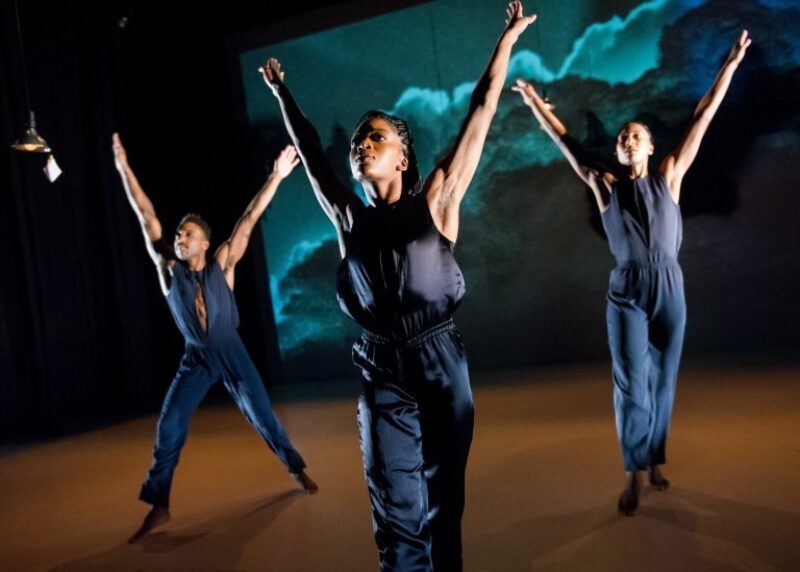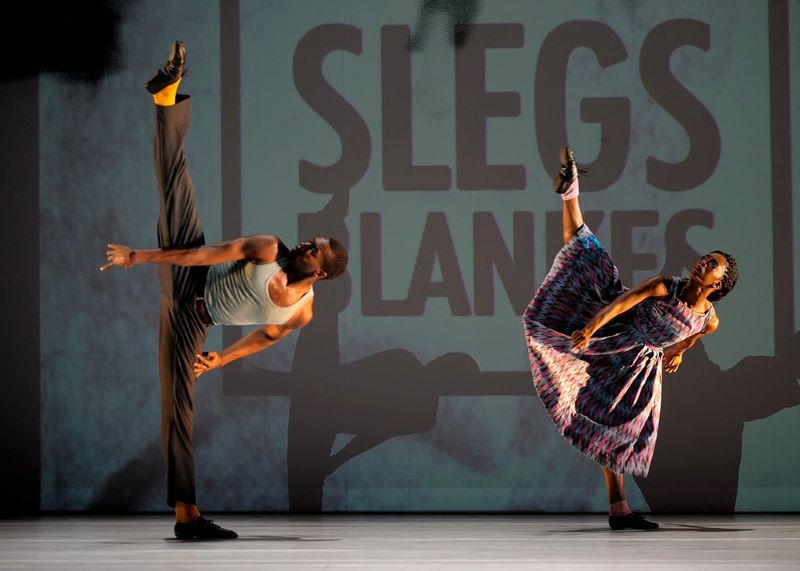Commemoration and Confusion
Review of When the Wolves Came In by Kyle Abraham/A.I.M on OntheBoards.tv
Written by Teen Editor Anya Shukla and edited by Press Corps Teaching Artist Imana Gunawan

I first watched When the Wolves Came In without looking at the program notes, and I was more than a little confused. In the performance, I saw wigs, hip-hop, ballet, images from apartheid, police brutality, but no central message. What did it all mean?
Although I did not know it at the time, When the Wolves Came In is based on Max Roach’s jazz album We Insist Freedom Now, created to commemorate the 100th anniversary of the Emancipation Proclamation, but released early in response to Civil Rights protests. The dance itself consists of three shorter pieces, the abstract “When the Wolves Came In,” “Hallowed,” and the more narrative-driven “The Gettin’.”
“When the Wolves Came In” felt uptight and European. The classical organ music paired with the large, uncomfortable-looking wigs the dancers wear, bring to mind Baroque European tradition. There are multiple instances when a dancer breaks out into hip-hop-inspired dance (some even twerk for a second or two), but those moments end quickly, marking a return to staid balletic movements.
There’s also a strange section in this piece where one wig-wearing dancer poses like a hunting dog, one “paw” extended, next to their wigless “owner,” who places his hands by his hip, almost as if he’s resting them on a sword. It’s a classical painting come to life.
The classicism doesn’t last forever: one dancer takes the wig off of another. The now de-wigged dancer stands in the center of the stage, bent over, unmoving, at a loss for movement; then they come back to life, and their dancing increases in drive and intensity.
I didn’t understand this at first, but after mulling the piece over, “When the Wolves Came In” brings to mind colonial rule. The wigs, the classical dancing, the music—all represent European power. When the wigs are taken off, there’s a moment of uncertainty, but then a renewed vigor in dancers’ movements, perhaps like several former European colonies after they gained independence.
“Hallowed” builds off of the contemporary/historical juxtaposition of “When the Wolves Came In.” The music is interspersed with what sounds like audience members screaming, almost as if they were at a hip-hop competition, and the three black dancers, moving with sharp confidence, feed off of that energy for brief moments before subsiding back into smooth, fluid movements. As the piece goes on, the balletic movement devolves; for example, one dancer turns with a flexed foot and her arms angled; all three hit their shoulders with their arms like swimmers before a race. Essentially, the dancers move away from the European tradition and towards their own individual style, one informed by casual, everyday movements.

“The Gettin’” is starkly different from the two pieces that came before it. At the beginning of the piece, the background featured a sign with the words “WHITE AREA” in both English and Dutch, so I instantly knew this piece would grapple with race relations and apartheid. The dancers entered wearing either buttoned-up shirts tucked into pants or checkered dresses that billowed out into a bell shape when they spun. As excited drumming began, the dancers twirled often and moved with frenetic energy across the floor. A sense of youthful exuberance abounded: at one point, one woman jumped rope. Then, many of the dancers moved offstage, leaving behind two men—one white and facing the audience, one black and facing the backdrop—standing on opposite sides of the stage. Both slowly slumped to the floor.
This next mini-duet had a clear message: the two dancers performed the same athletic movements, but for the most part, they did not touch; in one instance, the black man tried to lean on the white, but the latter quickly moved out of the way. Regardless of race, they both possessed the same abilities, but the white man refused to acknowledge his peer. As the piece progressed, they did interact physically, but their connection was never positive. When they hugged, for example, the white man rubbed his hand in the black man’s hair until he tore himself away from their embrace.
At the end of the duet, the two found themselves at the back of the room when clips of police brutality began to play on the backdrop. The soundtrack featured throaty, elegant screams. Then, the white man exited, and two black dancers entered. The three individuals onstage stood together like they were posing for a family portrait; perhaps because they were all standing as equals, this was a far different picture than the one taken earlier.
The piece ended with a black woman standing in the middle of the stage. As she moved her arms frantically, almost like a bird with a broken wing attempting to fly, someone spoke in the soundtrack: “I am all the ways I have failed. I am the black slave owner… the buyer of Dr. Palmer’s skin whitener.” The dancer suddenly stilled as the soundtrack continued, “I am all the ways I’ve survived.” As the disembodied voice listed numerous examples of black people’s successes, the curtain began to close, and the woman slowly walked offstage. Even though she wasn’t depicted as royalty, she was regal in her exit.
The first time I watched When the Wolves Came In, I spent the first thirty minutes of the performance struggling to understand the meaning behind the costumes and the dancing. Even “The Gettin’,” the most accessible section without background information, could prove difficult to understand if a viewer wasn’t familiar with Apartheid or infamous cases of police brutality (I would hope this wasn’t the case, however!). To be frank, I don’t remember the show very well: I was so busy trying to figure out what it all meant that I couldn’t actually take in the piece.
However, I don’t believe Abraham created this piece to educate others or protest injustices; if that were the case, the show’s meaning would have been clarified, so all audience members could understand its message. When the Wolves Came In is more of a commemorative catharsis: a remembrance of the Emancipation Proclamation and the successes of the Civil Rights movement, a decrying of Apartheid and colonialism. Though the abstraction of the first two pieces could confound the viewer, this historically-based artwork does shed light on black history.
When the Wolves Came In was performed at The Moore Theater, presented by STG and On the Boards in 2015, and is currently available to watch on OntheBoards.TV.
Lead photo credit: "Hallowed" by Kyle Abraham. Photo by Ian Douglas.
This review was written as part of mentorship program where members of the Teen Editorial Staff receive one-on-one mentorship by Press Corps Teaching Artists and professional critics. The Teen Editorial Staff is made up of 6 teens who lead the TeenTix Newsroom and curate the review portion of the TeenTix blog. More information about the Teen Editorial Staff can be found HERE.
The TeenTix Press Corps promotes critical thinking, communication, and information literacy through criticism and journalism practice for teens. For more information about the Press Corps program see HERE.


